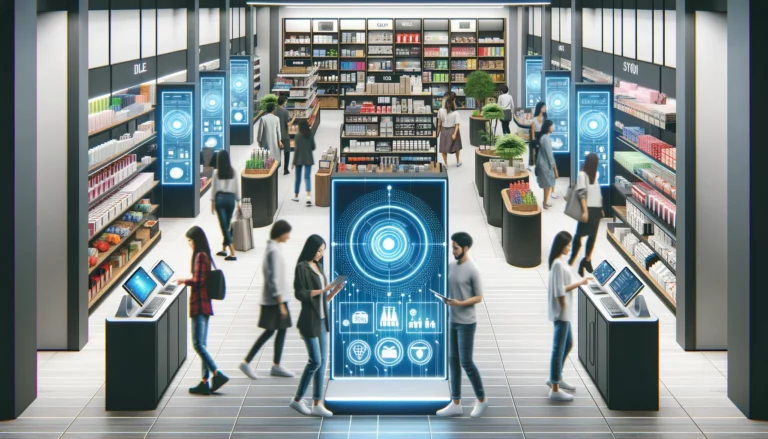What Will Retail Look Like in 2050?
The retail landscape has continuously evolved, adapting to technological advancements and changing consumer preferences. As we look ahead to 2050, the question arises: What will retail look like in 2050? This article delves into the future of retail, exploring anticipated trends, innovations, and transformations that will define the shopping experience in the coming decades.

The Emergence of Hyper-Personalization
AI-Driven Customer Insights
Artificial intelligence (AI) will reach unprecedented levels of sophistication by 2050, enabling hyper-personalized shopping experiences. AI will analyze vast amounts of data to understand individual customer preferences, predicting needs and desires with remarkable accuracy. This will allow retailers to offer highly tailored product recommendations, promotions, and shopping experiences that feel uniquely customized for each consumer.
Predictive Shopping Assistants
By 2050, AI-powered predictive shopping assistants will become commonplace. These virtual assistants will anticipate a shopper’s needs before they even know they have them. For example, they might suggest replenishing household items or offer fashion advice based on upcoming events in a customer’s calendar. This level of personalization will transform the shopping experience, making it more intuitive and seamless.
The Evolution of Physical Retail Spaces
Experiential and Interactive Stores
Physical stores will evolve into interactive and experiential spaces where the primary focus is on engagement rather than just transactions. Retailers will create immersive environments that blend entertainment, education, and shopping. For instance, fashion stores might offer virtual runway shows and customization workshops, while grocery stores could feature interactive cooking classes using in-store products.
Integration of Smart Technology
Smart technology will be integral to physical retail spaces. Stores will be equipped with advanced sensors, IoT devices, and augmented reality (AR) displays. Smart shelves will automatically update prices and stock levels, while AR displays will provide detailed product information and virtual try-on experiences. These technologies will create a seamless and engaging shopping journey, enhancing customer satisfaction.
The Dominance of E-Commerce and Digital Retail
Virtual Reality Shopping
Virtual reality (VR) will revolutionize e-commerce by 2050. Shoppers will be able to enter fully immersive virtual stores from the comfort of their homes. These virtual environments will replicate the experience of walking through a physical store, complete with virtual aisles and interactive displays. VR shopping will combine the convenience of online shopping with the sensory experience of in-store browsing.
Autonomous Delivery Systems
The future of retail logistics will be dominated by autonomous delivery systems. Drones, self-driving vehicles, and robotic couriers will ensure rapid and efficient delivery of goods. These systems will be capable of delivering products within minutes of an order being placed, significantly enhancing customer convenience and satisfaction. Retailers will invest heavily in these technologies to stay competitive in the fast-paced market.
Sustainable and Ethical Retail Practices
Circular Economy Models
Sustainability will be a central focus for retailers in 2050. The adoption of circular economy models will become widespread, with businesses designing products for longevity, reuse, and recycling. Retailers will offer take-back programs and repair services, encouraging customers to return used items for refurbishment or recycling. This approach will minimize waste and reduce the environmental impact of retail operations.
Transparent and Ethical Supply Chains
Consumers in 2050 will demand transparency and ethical practices from retailers. Blockchain technology will enable complete traceability of products, allowing consumers to verify the origin and journey of the items they purchase. Retailers will be held accountable for their sourcing and manufacturing processes, and those that prioritize ethical practices will gain a competitive advantage.
The Role of Data and Advanced Analytics
Real-Time Data Integration
Data will be at the heart of retail operations in 2050. Real-time data integration will allow retailers to make instant, informed decisions. Advanced analytics will provide insights into customer behavior, market trends, and supply chain efficiency. This data-driven approach will enable retailers to optimize every aspect of their business, from inventory management to personalized marketing.
Enhanced Customer Engagement
Advanced analytics will also enhance customer engagement. By understanding customer preferences and behaviors, retailers can create highly targeted marketing campaigns and personalized shopping experiences. Predictive analytics will allow retailers to anticipate customer needs and proactively address them, building stronger relationships and increasing loyalty.
The Impact of Global Economic and Social Trends
Economic Resilience and Adaptability
Retailers will need to be resilient and adaptable to navigate the economic uncertainties of 2050. Global economic shifts, including fluctuating currencies, trade dynamics, and geopolitical tensions, will impact consumer spending. Retailers will adopt flexible business models and diversify their supply chains to mitigate risks and maintain stability in the face of economic challenges.
The Rise of Emerging Markets
Emerging markets will play a significant role in the retail landscape of 2050. As incomes rise in developing regions, there will be a growing demand for consumer goods. Retailers that can effectively enter and cater to these markets will experience significant growth. Understanding local cultures, preferences, and regulatory environments will be crucial for success in these regions.
The Future Workforce in Retail
Automation and Human Collaboration
Automation will transform the retail workforce by 2050. Routine tasks such as inventory management, checkout, and delivery will be handled by robots and AI systems. However, human employees will still play a vital role in areas that require creativity, empathy, and complex decision-making. Retailers will focus on creating a collaborative environment where humans and machines work together seamlessly.
Continuous Learning and Development
The future retail workforce will require continuous learning and development to keep pace with technological advancements. Retailers will invest in training programs to equip employees with the skills needed for a tech-driven environment. Lifelong learning will become a norm, ensuring that employees remain adaptable and capable of contributing to the business’s success.
Conclusion: Embracing the Future of Retail
In conclusion, the retail industry in 2050 will be characterized by hyper-personalization, technological integration, sustainability, and data-driven decision-making. Retailers that embrace these trends and adapt to changing consumer expectations will thrive in the future. The shopping experience will be transformed into an immersive, seamless, and engaging journey that prioritizes customer satisfaction and ethical practices.
As we look towards 2050, retailers must remain innovative, resilient, and customer-centric to succeed in this dynamic landscape. The future of retail is bright, and those who are prepared to embrace change will lead the way in shaping the next era of shopping.



